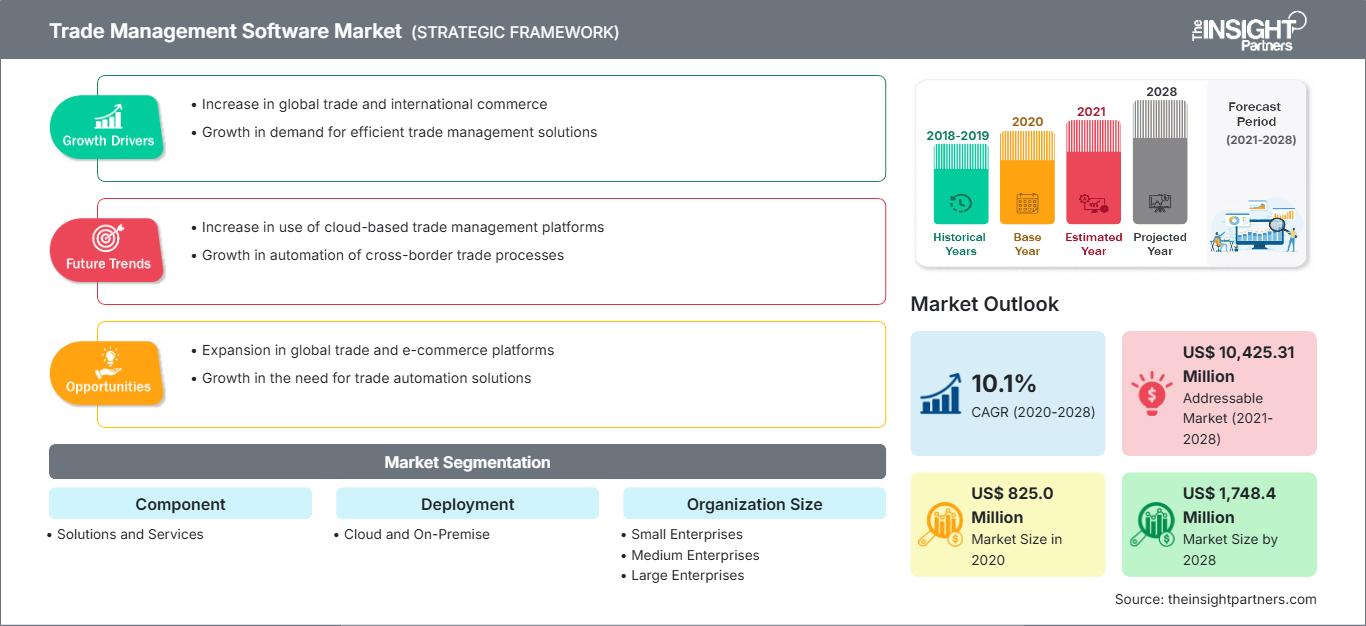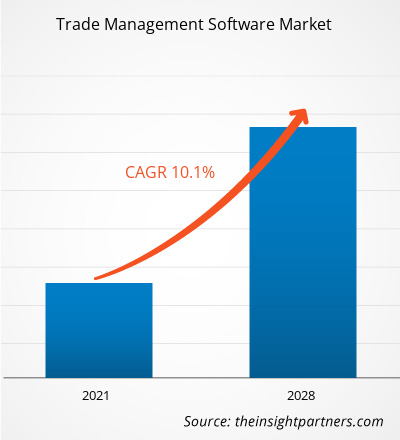[Rapporto di ricerca]In termini di fatturato, il mercato globale dei software per la gestione del commercio è stato valutato a 825,0 milioni di dollari nel 2020 e si prevede che raggiungerà i 1.748,4 milioni di dollari entro il 2028; si prevede una crescita a un CAGR del 10,1% nel periodo di previsione dal 2020 al 2028.
Il mercato dei software per la gestione del commercio è ampiamente segmentato in cinque regioni principali: Nord America, Europa, APAC, MEA e SAM. La regione APAC ha dominato il mercato dei software per la gestione del commercio nel 2020. L'APAC comprende molti paesi in via di sviluppo che stanno assistendo a una forte crescita nei rispettivi settori manifatturieri; la regione è diventata un polo manifatturiero globale. La Cina, così come altri paesi in via di sviluppo come India, Corea del Sud, Taiwan e Vietnam, stanno spingendo diverse aziende a delocalizzare i loro impianti di produzione poco o mediamente qualificati nei paesi vicini, che offrono manodopera a un costo inferiore. Inoltre, i governi di questi paesi stanno adottando misure per migliorare gli investimenti esteri nella regione. Nel corso degli anni, la spesa manifatturiera della regione è cresciuta in modo significativo e si prevede che continuerà a crescere a un tasso di crescita sostenuto. Questa crescita esponenziale della spesa manifatturiera e l'adozione di nuove tecnologie sono i fattori chiave che alimentano la domanda di software per la gestione del commercio nella regione.
Impatto della pandemia di COVID-19 sul mercato dei software per la gestione del commercio
La pandemia di COVID-19 ha colpito tutte le aziende a livello globale da dicembre 2019. La continua crescita del numero di pazienti infetti dal virus ha costretto i governi a bloccare il trasporto di persone e merci. Il settore manifatturiero ha subito gravi perdite a causa della chiusura temporanea delle fabbriche e dei bassi volumi di produzione, che hanno ostacolato la crescita dei settori della vendita al dettaglio, dell'e-commerce e della logistica. Inoltre, le misure di distanziamento sociale o fisico imposte dai governi hanno imposto limitazioni alle operazioni della logistica e di altri fornitori di servizi. Questa interruzione ha causato un calo delle attività commerciali. Queste avversità hanno portato a una riduzione del 17,7% dei volumi commerciali globali a maggio 2020, rispetto ai volumi di maggio 2019. Il calo nei primi 5 mesi del 2020 è stato pervasivo, tuttavia ha avuto un impatto significativo sulle esportazioni da Giappone, Stati Uniti e paesi europei. Nonostante le interruzioni causate dalla pandemia di COVID-19, è probabile che il commercio riprenda in futuro, con la ripresa delle attività dopo un lungo lockdown. Con le misure di distanziamento sociale in vigore, l'e-commerce, la logistica, la vendita al dettaglio e altri settori coinvolti nelle attività commerciali si stanno concentrando sull'adozione di software di gestione del commercio, per soddisfare la conformità garantendo la velocità della supply chain. Pertanto, le incertezze introdotte dal COVID-19 hanno ampliato la portata dell'utilizzo di software/SaaS basati su cloud nella logistica.
Personalizza questo rapporto in base alle tue esigenze
Potrai personalizzare gratuitamente qualsiasi rapporto, comprese parti di questo rapporto, o analisi a livello di paese, pacchetto dati Excel, oltre a usufruire di grandi offerte e sconti per start-up e università
Mercato del software di gestione commerciale: Approfondimenti strategici

- Ottieni le principali tendenze chiave del mercato di questo rapporto.Questo campione GRATUITO includerà l'analisi dei dati, che vanno dalle tendenze di mercato alle stime e alle previsioni.
Approfondimenti di mercato: riduzione dei costi di mercato e visibilità in tempo reale per i software di gestione commerciale
Potrai personalizzare gratuitamente qualsiasi rapporto, comprese parti di questo rapporto, o analisi a livello di paese, pacchetto dati Excel, oltre a usufruire di grandi offerte e sconti per start-up e università
Mercato del software di gestione commerciale: Approfondimenti strategici

- Ottieni le principali tendenze chiave del mercato di questo rapporto.Questo campione GRATUITO includerà l'analisi dei dati, che vanno dalle tendenze di mercato alle stime e alle previsioni.
Il commercio è un processo complesso che coinvolge il flusso di molteplici beni e informazioni attraverso una rete di fornitori, corrieri e magazzini. Le soluzioni software aiutano gli utenti a gestire queste complessità in modo più preciso e semplice attraverso l'analisi di dati in tempo reale e reali, riducendo così le inefficienze. L'implementazione di questi sistemi software migliora anche il funzionamento della supply chain e offre visibilità in tempo reale sulle operazioni. La maggiore competitività in diversi settori è una forza importante che li spinge a investire in automazione e digitalizzazione. Inoltre, l'adozione di soluzioni basate su cloud offre una maggiore visibilità in tempo reale sui beni esportati e riduce i costi operativi. L'implementazione di tecnologie emergenti come blockchain, intelligenza artificiale (IA) e analisi predittiva nelle operazioni logistiche stimolerà ulteriormente la crescita del mercato globale dei software di gestione commerciale nei prossimi anni.
Approfondimenti sui segmenti dei componenti
In base ai componenti, il mercato dei software di gestione commerciale è segmentato in soluzioni e servizi. Si prevede che il segmento delle soluzioni sarà il segmento leader nel mercato globale dei software per la gestione del commercio durante il periodo di previsione. Il segmento delle soluzioni include la conformità commerciale e la visibilità e l'esecuzione del commercio internazionale. Inoltre, le operazioni di visibilità e esecuzione del commercio internazionale includono spedizioni e trasporti transfrontalieri. Offrono visibilità sugli eventi e sui processi dei partner commerciali internazionali. Questi processi devono essere internazionali e includere transazioni e accordi tra partner commerciali.
Approfondimenti sul segmento di distribuzione
In base alla distribuzione, il mercato dei software per la gestione del commercio è segmentato in on-premise e cloud. È probabile che il segmento cloud sia il segmento leader nel mercato globale dei software per la gestione del commercio durante il periodo di previsione. L'implementazione cloud è ampiamente adottata dalle piccole e medie imprese. I bassi costi di proprietà, i costi ridotti di manutenzione e aggiornamento e l'accesso alle funzionalità più recenti sono tra i principali vantaggi dell'implementazione cloud rispetto all'implementazione on-premise.
Approfondimenti sul segmento delle dimensioni dell'organizzazione
In base alle dimensioni dell'organizzazione, il mercato dei software per la gestione del commercio è segmentato in piccole imprese, medie imprese e grandi imprese. Si prevede che il segmento delle grandi imprese sarà il segmento leader nel mercato globale dei software per la gestione del commercio durante il periodo di previsione. A livello globale, si registra un aumento della domanda di software per la gestione del commercio tra diverse organizzazioni, per aumentare l'efficienza e ridurre al minimo i costi operativi complessivi. L'adozione di questo software è una pratica comune tra le grandi imprese per costruire una supply chain adeguata e ottenere flessibilità nelle operazioni complessive.
Approfondimenti sui segmenti di settore
In base al settore, si prevede che il segmento della logistica e dei trasporti sarà il segmento leader nel mercato globale dei software per la gestione del commercio durante il periodo di previsione. La domanda di fornitori di servizi logistici che offrono servizi che vanno oltre quelli tradizionali è in aumento. In alcuni casi, i fornitori di servizi logistici terzi gestiscono le zone di libero scambio dei loro partner. Inoltre, in altri casi, forniscono servizi di magazzinaggio e servizi a valore aggiunto associati alla produzione o all'approvvigionamento di merci. Inoltre, organizzano tutti i processi logistici e di trasporto essenziali per trasferire le merci dalla fonte agli utenti finali in modo efficiente ed economico.
Gli operatori del mercato si stanno concentrando su innovazioni e sviluppi di nuovi prodotti integrando tecnologie e funzionalità avanzate nei loro prodotti per competere con i concorrenti.
- A gennaio 2021, SAP Hong Kong e la società di consulenza Deloitte hanno stretto una partnership per offrire vantaggi sostanziali alle aziende impegnate nel commercio transfrontaliero.
- A gennaio 2019, Bamboo Rose ha lanciato i servizi come modello di abbonamento, che aiuta i clienti a pianificare meglio, innovare e collaborare con le loro comunità di vendita al dettaglio multi-aziendali, risparmiando dal 10 al 30% sugli investimenti tecnologici.
- A marzo 2019, Thomson Reuters ha acquistato Integration Point, fornitore di software per la gestione del commercio globale (GTM), per un importo non divulgato, in un accordo che amplia significativamente il suo bacino di clienti importatori ed esportatori con sede in Nord America.
Approfondimenti regionali sul mercato dei software di gestione commerciale
Le tendenze regionali e i fattori che influenzano il mercato del software di gestione del commercio durante il periodo di previsione sono stati ampiamente spiegati dagli analisti di The Insight Partners. Questa sezione analizza anche i segmenti e la geografia del mercato del software di gestione del commercio in Nord America, Europa, Asia-Pacifico, Medio Oriente e Africa, America meridionale e centrale.
Ambito del rapporto di mercato sul software di gestione commerciale
| Attributo del rapporto | Dettagli |
|---|---|
| Dimensioni del mercato in 2020 | US$ 825.0 Million |
| Dimensioni del mercato per 2028 | US$ 1,748.4 Million |
| CAGR globale (2020 - 2028) | 10.1% |
| Dati storici | 2018-2019 |
| Periodo di previsione | 2021-2028 |
| Segmenti coperti |
By Componente
|
| Regioni e paesi coperti | Nord America
|
| Leader di mercato e profili aziendali chiave |
|
Densità degli operatori del mercato del software di gestione commerciale: comprendere il suo impatto sulle dinamiche aziendali
Il mercato dei software per la gestione del commercio è in rapida crescita, trainato dalla crescente domanda degli utenti finali, dovuta a fattori quali l'evoluzione delle preferenze dei consumatori, i progressi tecnologici e una maggiore consapevolezza dei vantaggi del prodotto. Con l'aumento della domanda, le aziende stanno ampliando la propria offerta, innovando per soddisfare le esigenze dei consumatori e sfruttando le tendenze emergenti, alimentando ulteriormente la crescita del mercato.

- Ottieni il Mercato del software di gestione commerciale Panoramica dei principali attori chiave
- Soluzione
- Servizi
Mercato del software di gestione commerciale - per distribuzione
- On-premise
- Cloud
Mercato del software di gestione commerciale - per dimensione dell'organizzazione
- Grandi imprese
- Medie imprese
- Piccole imprese
Mercato del software di gestione commerciale - per utente finale
- Vendita al dettaglio e CG
- Automotive
- Logistica e trasporti
- Sanità e farmaceutica
- Governo
- Aerospaziale e difesa
- Prodotti chimici e minerali
- Produzione
- Altro
Mercato del software di gestione commerciale – per regione
Nord America
- Stati Uniti
- Canada
- Messico
Europa
- Francia
- Germania
- Italia
- Regno Unito
- Russia
- Resto d'Europa
Asia Pacifico (APAC)
- Cina
- India
- Corea del Sud
- Giappone
- Australia
- Resto dell'APAC
Medio Oriente e Africa (MEA)
- Sudafrica
- Arabia Saudita
- Emirati Arabi Uniti
- Resto del MEA
Sud America (SAM)
- Brasile
- Argentina
- Resto del SAM
Mercato del software di gestione commerciale - Profili aziendali
- Amber Road, Inc.
- Bamboo Rose LLC
- Expeditors International of Washington, Inc.
- Integration Point, LLC
- Livingston International
- MIC
- Oracle Corp
- QAD, Inc
- QuestaWeb
- SAP SE
- Analisi storica (2 anni), anno base, previsione (7 anni) con CAGR
- Analisi PEST e SWOT
- Valore/volume delle dimensioni del mercato - Globale, Regionale, Nazionale
- Industria e panorama competitivo
- Set di dati Excel
Report recenti
Rapporti correlati
Testimonianze
Motivo dell'acquisto
- Processo decisionale informato
- Comprensione delle dinamiche di mercato
- Analisi competitiva
- Analisi dei clienti
- Previsioni di mercato
- Mitigazione del rischio
- Pianificazione strategica
- Giustificazione degli investimenti
- Identificazione dei mercati emergenti
- Miglioramento delle strategie di marketing
- Aumento dell'efficienza operativa
- Allineamento alle tendenze normative






















 Ottieni un campione gratuito per - Mercato del software di gestione commerciale
Ottieni un campione gratuito per - Mercato del software di gestione commerciale